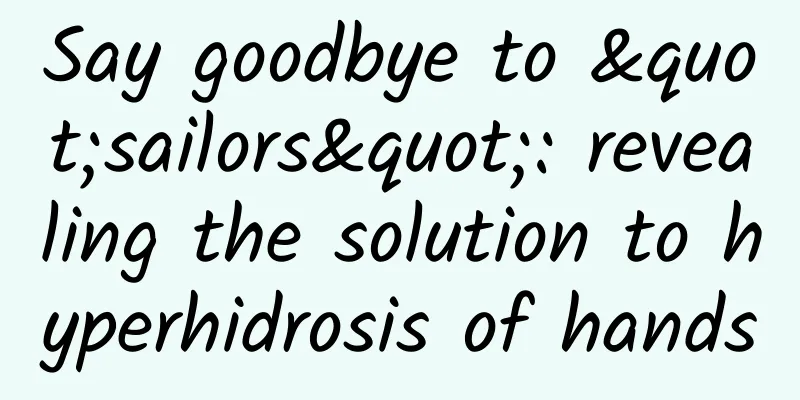Say goodbye to "sailors": revealing the solution to hyperhidrosis of hands

|
Author: Liu Yanguo, Chief Physician, Peking University People's Hospital Reviewer: Shi Wenzai, attending physician at Peking University International Hospital Sweating, as a natural physiological regulation mechanism of the human body, is essential for maintaining a constant body temperature. However, for some people, excessive sweating of the palms has become a problem, seriously affecting their daily quality of life. We call this condition "hyperhidrosis of the palms". 1. Causes and characteristics of hyperhidrosis of hands Hyperhidrosis of the hands, as the name suggests, refers to the phenomenon of abnormal sweating of the hands. The palms of the patient will sweat frequently and profusely when they are emotionally tense or in a hot environment. In severe cases, water droplets may form, which will affect basic activities such as writing, using electronic devices, and social handshakes, causing great trouble to the patient's life. The results of epidemiological surveys in my country show that the prevalence rate is about 2%. Figure 1 Original copyright image, no permission to reprint Hyperhidrosis of the hands is mainly a congenital disease, and its pathogenesis is closely related to genetic factors. Patients usually have symptoms of excessive sweating in the palms since childhood. It is worth noting that although hyperhidrosis of the hands has a certain genetic tendency, it is not a hereditary disease, and its inheritance probability is about 30%. In addition, the diagnosis of hyperhidrosis of the hands is mainly based on subjective feelings, that is, the pain caused to the patient by continuous and heavy sweating of the palms, and the patient's willingness to actively seek treatment, rather than specific objective indicators. Environmental factors can also have a certain impact on the clinical manifestations of hyperhidrosis. For example, when patients are nervous, hot, or engaged in physical or mental activities, the amount of sweating will increase significantly. When patients with hyperhidrosis sleep at night, their palms are usually dry; and in a calm state during the day, sweating may also decrease or disappear. Treatment of hyperhidrosis of hands Traditional treatments for hyperhidrosis include oral medications, topical astringents or corrosives, and botulinum toxin injections, but the therapeutic effects of these methods are often limited and short-lived. Currently, thoracic sympathectomy under thoracoscopic surgery is considered to be the most effective method for treating hyperhidrosis. This surgery reduces palmar sweating by cutting off the sympathetic nerve branches that innervate the sweat glands in the palms. Specifically, the operation will make a small incision of about 5-10 mm in the patient's armpit, use a thoracoscope to enter the chest cavity, and accurately cut the target nerve. If everything goes well, the single-sided operation time is about 5-10 minutes, and the total duration of bilateral surgery is no more than 20 minutes. The patient is under general anesthesia during the operation, so he will not feel any discomfort. Figure 2 Original copyright image, no permission to reprint However, surgical treatment is not suitable for all patients. Surgery for hyperhidrosis is usually suitable for patients with moderate to severe hand sweating, that is, people whose hand sweating seriously affects their daily life. This type of surgery is not recommended for patients who have had pleurisy, tuberculosis or severe pneumonia that has caused pleural adhesions, and for patients with significant bradycardia, because these conditions increase the risk of surgery. 3. Postoperative Condition The effectiveness of surgery for hyperhidrosis of the hands can reach 95%-100%. Patients may experience a short period of pain after surgery, especially in the wound and back area, but this pain can usually be relieved by appropriate analgesics and gradually decreases until it disappears within a week. A common side effect that may occur after surgery is increased sweating in other parts of the body, such as the chest and back, and the extent of this phenomenon varies from person to person. Depending on the specific method of surgery, that is, the different parts of the sympathetic nerves that are cut (T3 or T4), the postoperative effects will also be different. T3 cutting will lead to drier palms, but its side effects are relatively large; T4 cutting has milder side effects, but some patients still have sweaty palms after surgery. Patients can make personalized choices based on doctor's advice and personal preferences. |
>>: How to take care of appendicitis after surgery? Start with the wound, activities, and diet!
Recommend
How long can glass glue be exposed to water in summer? How to remove moldy and black glass glue?
There are many types of glass glue on the market,...
Is it normal for my period to be delayed by four days?
We all know that I believe many female friends ha...
Signs of good recovery of uterus after uterine curettage
During the period of extracorporeal pregnancy, ma...
Why is the nipple itchy?
In our real life, many women have experienced itc...
Long-term depression in women
In this stressful modern society, more and more f...
Can the fallopian tube be reconnected after removal?
Ectopic pregnancy is also a common ectopic pregna...
Nine symptoms of urinary tract infection in women
Nowadays, the pace of life is fast, and the press...
Can congenital uterine septate be aborted?
A septate uterus is a uterine developmental malfo...
What is the cause of pain in the left side of the appendage?
The female urinary system plays an important role...
What causes breast shrinkage?
What causes breast shrinkage? As age increases, t...
What tests should I do before getting pregnant?
Nowadays, people advocate eugenics and good paren...
Where is the female kidney located?
For each part of the human body, it is estimated ...
Can I eat on the train during the epidemic? How to eat on the train during the epidemic
We all know that during the epidemic, everyone tr...
Vulvar itching a few days before menstruation
Speaking of menstruation, I believe every woman h...
What should I do if I feel cold after an abortion?
Abortion can cause great harm to women's bodi...









